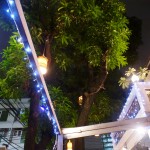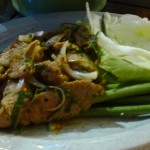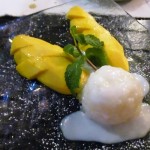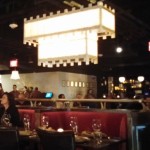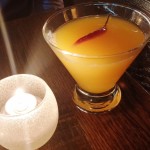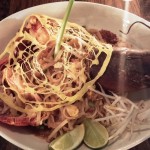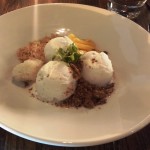A Tale of Two Mango Trees:
Mango Tree DC opened last month in Washington, D.C.’s CityCenter. It’s the first U.S. location of the international Thai chain launched in Bangkok, Thailand in 1994. Having recently spent a month in Thailand, I jumped at the chance to explore the restaurant and its roots more deeply. As such, I visited the original Mango Tree in Bangkok and just 10 days later dined at the freshly opened Mango Tree DC.
The restaurants of course differ greatly in terms of everything from concept to ambiance to the actual menu, however there is a shared, core vision — making authentic Thai flavors and dishes more readily available and widely accepted by an international audience who is more familiar with a rather toned down and bland rendition of the country’s fare.
The Original Mango Tree in Bangkok, Thailand
Pitaya Phanphensophon founded Mango Tree in Bangkok in 1994. The multi-level restaurant features an open air courtyard beautifully landscaped with the restaurant’s eponymous mango tree. The tree was planted 80 years ago and today reaches across the restaurant’s entrance as a welcoming presence. The building itself dates back to the era of the Thai king Rama VI, several decades prior to when the mango tree was planted in that very spot.
A diversion on the kings of Thailand: The reigning Chakri Dynasty in Thailand has rulers referred to as Rama. The current king, Bhumibol Adulyadej, is Rama IX. In power since 1946, he’s the longest serving head of state in the world. Thailand is a constitutional monarchy, and while there has been political turmoil in recent years, the king is above and separate of that — nearly unanimously loved. In some ways, the level of reverence and respect is so great that he’s partly deified. Now 87 years old and in poor health, his eventual passing will be a wide-scale national tragedy.
The restaurant is located in the Silom district of Bangkok. Today, it also happens to be just a few blocks away from the notorious Patpong neighborhood, the epicenter for a very particular type of Thai tourism and nightlife. While that’s certainly not the crowd found at Mango Tree, the original restaurant in Bangkok does indeed cater to tourists.
An estimated 99% of the restaurant’s business in Bangkok comes from tourists, according to a friendly and knowledgeable server who heads their new location opening team. While he notes that the menu differs greatly from location to location, here at the original, the expansive menu features just about every Traditional Thai dish you could conjure up.
The menu is built for tourists, with English listings and descriptions next to those in Thai, and even the occasional photo or explanation of an ingredient. Still, unlike many restaurants who so clearly cater to tourists and in turn offer ho-hum, watered down fare, Mango Tree’s core vision remains, making authentic flavors and preparations approachable.
A few dishes sampled during our visit included a spicy beef Nam Tok salad, which showcased the perfect balance of Thai flavors such as fish sauce and lime. It offered a lingering heat which continued to build but yet never dominated your palate. A recommended tray of appetizers included shrimp and fish cakes, spring rolls, and chicken wrapped in banana leaves. The latter was the highlight, offering wonderfully juicy and succulent chicken bites with a touch of sweetness.
Entrees included a luscious green curry with beef, and a tangy, robust red curry with BBQ duck served in a pineapple. The curries at Mango Tree are creamy, with bold, rich flavors. They were perhaps the thickest of the innumerable curries enjoyed during a month spent in Thailand, and all throughout the country, different regions and restaurants offer unique takes on these classic Thai staples.
For consistency’s sake, Mango Tree actually has a factory in Thailand where they produce all of their curry pastes. These are then shipped across the world to their restaurants, at which point the local chefs will add all of the fresh produce, meats and other ingredients.
The meal ended with mango sticky rice draped in a sugary coconut sauce. Compared to other versions we had, this offered more intense flavors, the rice saltier, the sauce sweeter. The mango was impossibly fresh and juicy. It was delicious.
A great night cap for an evening spent experiencing the foods and the dedication to quality service which has seen Mango Tree quickly expand internationally, from London to Hong Kong, Tokyo to Dubai, now taking root in the U.S. as well. A second location is also on the way in Bangkok, in the prime real estate along the Chao Phraya river near the gorgeous temple and landmark Wat Arun.
Mango Tree DC in CityCenter
Richard Sandoval’s influence on the restaurant is immediate. The styling and setup, with its modern, sleek aesthetics and deep colors and hues calls to mind one of his many other D.C. restaurants. Yet, beyond offering advice on concepts and how to cater to the District crowd, he doesn’t have direct influence over the menu itself. Here, Chef de Cuisine Paul Kennedy is in charge.
Kennedy spent five years at Mango Tree Dubai, and was tasked with heading Mango Tree DC’s kitchen. His menu is designed to offer dishes from all four of Thailand’s major culinary regions, rich, hearty fare from the North, spicy dishes from the Northeast, Chinese-influenced dishes from Central Thailand, and hot, spicy fare from the South, while also taking those concepts and offering bold new twists and turns.
A warm greeting of sawatdee khap, hello, froze my brain as I entered the restaurant. Where exactly was I right now? Bangkok? Having just returned from Thailand, lost in a swirl of time zones, and dragging through a week of jet lag thanks to the 12-hour time difference and 36-hour trip home, it took a moment to catch up, and the quick mental lapse back to a month spent traveling and touring and relaxing and adventuring was much appreciated.
The menu at Mango Tree DC is far smaller than its Bangkok counterpart, although there are plans to continue adding more dishes as the restaurant works itself into a post-opening groove. There are both authentic dishes you’d expect to find well-prepared anywhere from Chiang Mai to Phuket, as well as dishes incorporating Thai flavors in ways you’d never see in Thailand.
For the former, the Som Tum green papaya salad provided another moment of instant transportation back to Thailand. Bright, crunchy and a touch of sour, all with a spicy bite. Other standby Thai dishes range from Pla Goong, a lemongrass and chile marinated shrimp dish, and the aforementioned Nam Tok salad, here offered with either pork neck or grilled steak, to Tom Kha Gai soup, a classic, creamy coconut and galangal chicken soup. Thai curry dishes, including green curry, red curry, and yellow Massaman curry are all available, as well as steamed or fried whole catch of the day.
Moving in the other direction is one of Mango Tree’s signature entrees, a pad Thai dish with Maine Lobster and tamarind sauce. The dish is served with the whole lobster shell on your plate, with the succulent meat then being mixed together with the fried noodles and sauce.
A diversion on pad Thai: Pad Thai is obviously, well, Thai. Yet, it’s not something most Thais would find themselves regularly eating — it’s more of a tourist food. Think of what Americans so often call “Mexican” food in this country, only to travel to Mexico, look around, and go, uh, hey, where do I find all the chalupas? During a day spent at a cooking class in Chiang Mai, participants chose their own dishes to create from the menu. The unlucky souls who chose pad Thai for an opening course were mercilessly mocked by the class’s otherwise cheery instructor.
Another nontraditional choice is the grilled Angus strip loin served with a northeastern Thai tamarind sauce on the side. The steak was perfectly cooked and juicy, although nothing about it was Thai — until you dipped it into that sauce, and were blasted with rich tamarind and a spicy chile kick. You’d be hard-pressed to find steak of that quality in Thailand, and it’s clear Mango Tree DC wants to capitalize on the type of great ingredients here which wouldn’t be readily available somewhere such as the Thai countryside.
To drink, find cocktails with Thai influences such as the Spicy Siam, with mango, chili-infused mango rum, Thai chili and fresh lime, the Lychee Mojito, Strawberry Basil Caipirinha, and the Khing Wiski, with rye whiskey, house-made ginger beer, lime, cilantro and chili ginger. Yes, you can also get your ubiquitous Thai staples — Singha or Chang beer. I don’t need to tell you how many of those I had in Thailand.
For dessert, you can find your traditional mango sticky rice, as well as a range of other choices, including a young coconut panna cotta with a cilantro and lime reduction, and a Thai street coconut ice cream dish, served surrounded by numerous components such as jack fruit, sticky rice, crushed peanut, toasted coconut, brownie crumbs and caramel sauce.
***
The two restaurants are, well, a world apart, and it’s not always easy to walk the fine line between paying homage to a traditional cuisine while reinventing it at the same time. Where Mango Tree DC is most successful thus far is with their authentic interpretations of classic dishes, and their commitment to showcasing Thai food’s omnipresent flavor-meld of sweet, sour, spicy and salty.
The more ways they can play around with those robust, bold flavors, the better. As the restaurant settles in, it will be exciting to see where they go, and whether there’s more of a turn towards tradition or reinvention.




